The Razer Blade 15 (2021) Review: Amped Up With Ampere
by Brett Howse on March 11, 2021 9:30 AM EST- Posted in
- Laptops
- Gaming
- Razer
- Razer Blade
- Ampere
Graphics Performance – Razer Goes Ampere
Just announced at CES in January, NVIDIA’s latest laptop graphics card lineup is now based on their latest generation Ampere platform, built on the 8 nm Samsung process. Razer is one of the first out of the gate to ship laptops with the new GPU.
When NVIDIA launched Pascal two generations ago, they were very happy to conclude that the laptop and desktop variants were similar enough in performance to drop the M badge (for Mobile) on the laptop-destined GPUs. Thanks to the low TDP and high efficiency of Pascal-based GPUs, performance was similar, even if the power output would be near the top of what a laptop could handle. NVIDIA also released Max-Q versions, which are the same basic GPU, binned a bit better, and run at a lower power limit.
With the heat limitations of laptop chassis, matching performance of laptops and desktops is a tough proposition. With Ampere, it gets even harder, as the power limits for the higher-end parts have gone up dramatically – a RTX 3070 desktop GPU has a higher TDP than a RTX 2080, all the while laptop cooling is all but unchanged. So, for this generation, NVIDIA has gone back to explicitly designating their laptop GPUs – literally calling them "GeForce RTX 30[xx] Laptop GPU" – indicating that the parts are destined for a thermally constrained environment. And, with less than half the TDP of the desktop cards, the performance of this generation of laptop parts is going to more widely diverge from the desktop than in past generations.
There are ways to combat this TDP discrepancy. The ridiculously parallel nature of graphics workloads means that NVIDIA would, in theory, be able to build wider GPUs, which run at a lower frequency, and don’t incur the exponential increase in power output with voltage. This is something they even did with the Pascal launch, with the RTX 1070 for laptops offering a few more CUDA cores than its desktop counterpart, but instead, the laptop GPUs offer far less CUDA cores than the desktop models.
The news is not all bad. Despite the Ampere-based laptop GPUs not being able to compete against their desktop counterparts, they are still a big upgrade over the RTX 20-series. Across the board, the new Ampere GPUs are about twice as wide as the outgoing models, and are based on the latest GPU architecture. It can easily get forgotten that while Ampere desktop parts reaped a good deal of their performance gains from increased power consumption, the laptop variants are still very much an upgrade over the outgoing RTX 20-series.
| NVIDIA GeForce RTX 30 Series Laptop Specifications | |||||
| RTX 3080 Laptop GPU |
RTX 3070 Laptop GPU |
RTX 3060 Laptop GPU |
|||
| CUDA Cores | 6144 | 5120 | 3840 | ||
| Boost Clock | 1245 - 1710MHz | 1290 - 1620MHz | 1283 - 1703MHz | ||
| Memory Bus Width | 256-bit | 256-bit | 192-bit | ||
| VRAM | 8GB / 16GB GDDR6 | 8GB GDDR6 | 6GB GDDR6 | ||
| TDP Range | 80 - 150W+ | 80 - 125W | 60 - 115W | ||
| GPU | GA104 | GA104 | GA106 | ||
| Architecture | Ampere | Ampere | Ampere | ||
| Manufacturing Process | Samsung 8nm | Samsung 8nm | Samsung 8nm? | ||
| Launch Date | 01/26/2021 | 01/26/2021 | 01/26/2021 | ||
The Razer Blade 15 comes with RTX 3060 and RTX 3070 option in the Base model, and RTX 3070 or RTX 3080 options in the Advanced model. Our Base model comes with the RTX 3070. Unfortunately, we don't have an RTX 2070 laptop on-hand for comparisons. As usual, we’ll start with a few synthetics, then some games.
3DMark
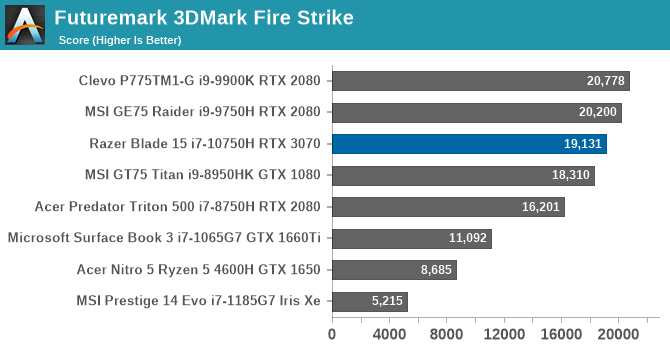
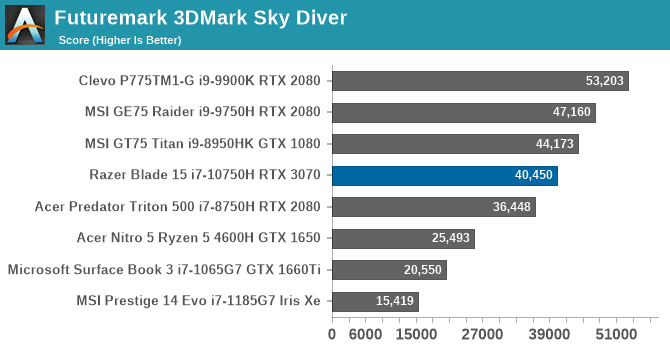
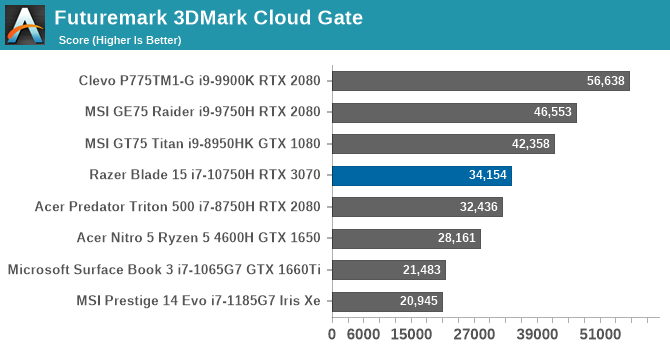
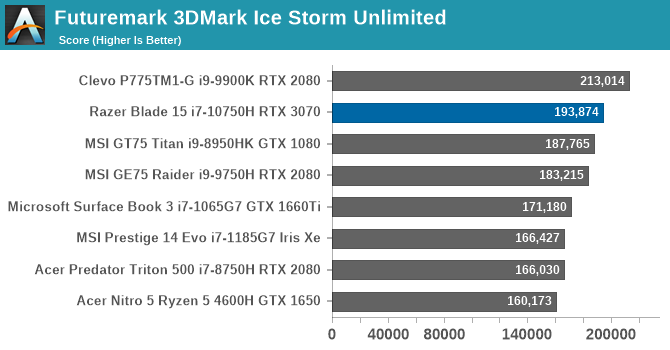
UL’s 3DMark suite offers a range of tests of varying complexity. The Razer Blade 15 with the RTX 3070 finished about mid-pack compared to some of the other gaming systems we’ve seen. Gaming systems can be thin and light designs like the Acer Predator Triton 500, and the Razer Blade series, or more of a desktop replacement such as the Clevo and MSI models shown here, which will have more headroom for thermals. The RTX 3070 paired with the Core i7-10750H seems to be able to be fairly close to the RTX 2080 models despite their higher thermal capacities.
GFXBench
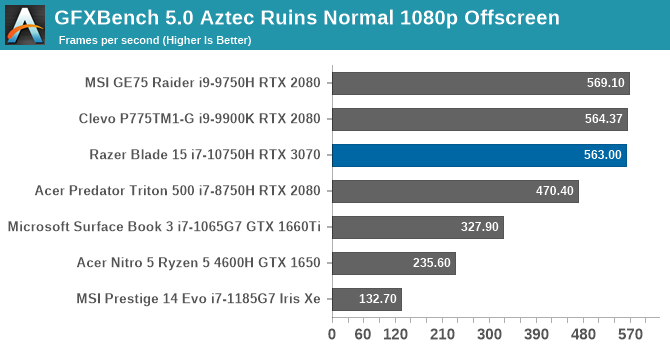
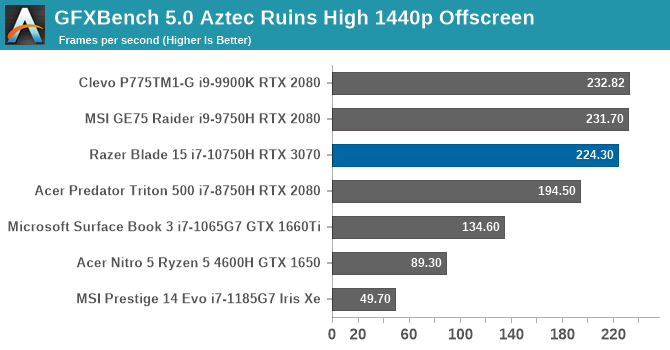
GFXBench added a DirectX 12 suite with the launch of version 5, and is cross-platform as well, although bit-wise the PC runs at 32-bit compared to 16-bit in the smartphone industry. In both tests, the RTX 3070, despite being in a thin and light design in the Razer Blade 15, was able to keep up with the RTX 2080 in much beefier laptops.
Tomb Raider
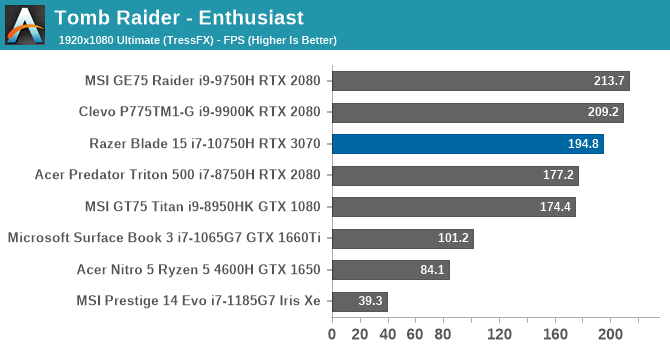
Although several years old now, the first game in the rebooted Tomb Raider franchise can still be demanding on laptops, but not with anything as powerful as this. Even at our maximum settings on 1920x1080, the laptop can easily out-pace its 165 Hz display refresh. Although we don’t normally test at 2560x1440 mostly due to most gaming laptops not supporting this resolution, the Razer Blade 15 would still hit 138 FPS average at the higher resolution. No issues here.
Rise of the Tomb Raider
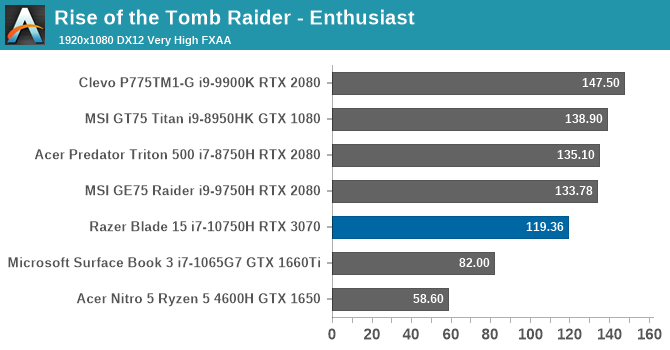
The second game in the series added DirectX 12, and was far more demanding on the graphics side. Here the Razer Blade 15 dips below all of the RTX 2080 laptops, although still can easily handle this game. At the native QHD resolution, the Razer Blade still managed 94 FPS average.
Shadow of the Tomb Raider
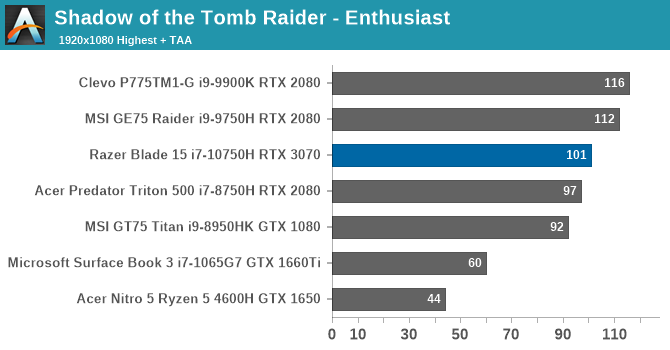
The most current game in the franchise is even more demanding, but whether due to drivers, or the new Ampere platform, the RTX 3070 is able to slot in again with the RTX 2080 slightly behind in Max-Q guise, and slightly ahead in the larger form factor gaming laptops. What is holding it back the most though is the CPU at this resolution, with the benchmark being GPU bound only 28% of the time. Bumping it up to QHD changes that to 82% GPU bound, with an average framerate of 79 FPS.
Strange Brigade
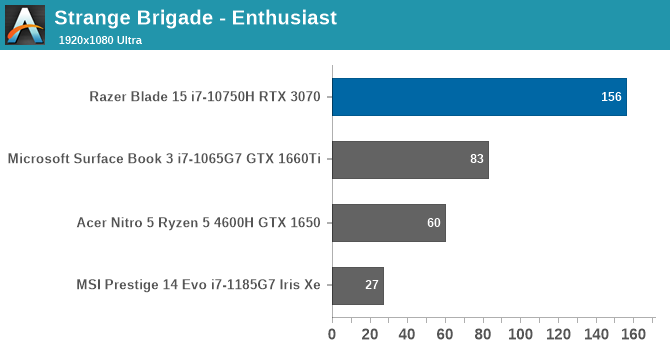
Another DirectX 12 game in the suite is Strange Brigade, set in ancient Egypt. This is one of the newest games in the suite, so we have the least amount of data for it. It is not the most demanding game, with the Razer Blade hitting 118 FPS even at QHD resolution.
Far Cry 5

Ubisoft’s Far Cry franchise is one of their most successful, and even though there is a new Red Dawn version of this game, it is based on the same engine. Far Cry can also be somewhat CPU bound, which shows why the Clevo with its desktop processor is so far ahead, but the Razer Blade still does very well here, outperforming several RTX 2080 laptops. At QHD, the framerate only dips to 91 FPS average, showcasing again that this game is very much CPU limited.
Shadow of War

The results in Shadow of War are very familiar, with the Razer Blade 15’s RTX 3070 really in the mix with the RTX 2080 laptops from a year ago. At QHD, the framerate dropped to a very playable 78 FPS average.
GPU Conclusion
Officially the NVIDIA naming scheme for the latest generation of Ampere GPUs bound for notebook computing is the RTX 30-Series Laptop GPUs. After a couple of generations of NVIDIA dropping the extra branding on their laptop GPUs, the difference in power requirements are just too large to ignore. Even with Pascal and Turing, desktop cards would always outperform their laptop brethren, but for Ampere NVIDIA has switched back to explicit laptop designations as the resulting performance is too far apart to be bundled together.
That being said, the RTX 3070 has shown itself to be very capable, mixing it up with the bigger, more expensive RTX 2080 from last generation. The Razer Blade Base model we are testing is also somewhat held back with the Core i7-10750H, as most of the time we are sampled the very top spec. It is kind of refreshing for Razer to offer the Base model, as it does highlight the differences. Although the less-expensive Razer Blade 15 Base model is a thin and light design, and although it does not offer the biggest, fastest CPU, the hex-core i7 and RTX 3070 are still a great combo, and fit the laptop very well.
Razer’s inclusion of a QHD display in the review unit seems to be the perfect fit for this combo as well, and although the Advanced model also offers a 1080p unit with an even higher refresh rate, the RTX 3070 Laptop GPU feels like it is a perfect fit with a high-refresh QHD panel. Even at the native resolution, framerates are more than acceptable.


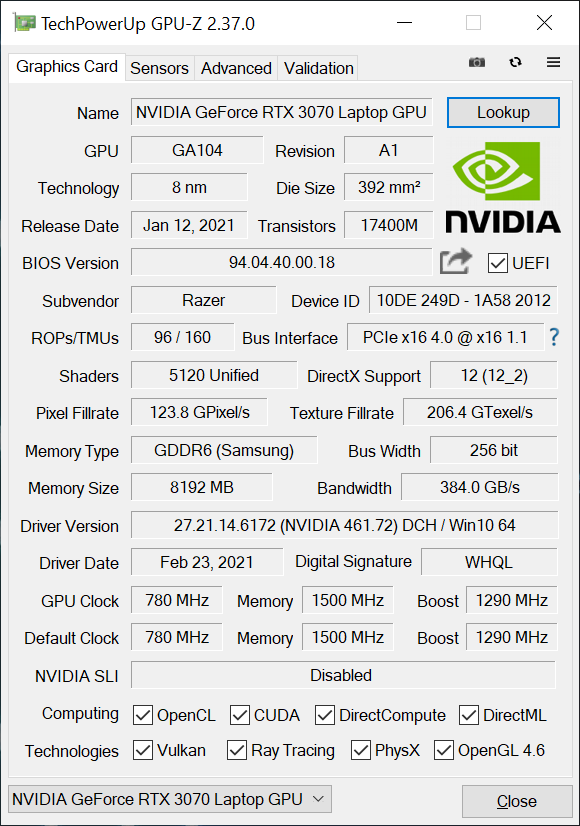








44 Comments
View All Comments
Brett Howse - Thursday, March 11, 2021 - link
Yes there is an entire industry of Clevo rebrands. Cheap. Powerful. Plastic. Heavy.Oxygen12 - Thursday, March 11, 2021 - link
This review surprised me a little bit.(I am an owner of a 2020 Razer Blade base with a max-q 2070 and OLED screen).
I am less glowing about the battery life, in my personal use, for whatever reason, background processes etc., I never reach four hours of battery life doing standard surfing activities. It's a tradeoff I am OK with, but do wish the life was longer... the battery shouldn't be smaller than the one in the advanced. I just couldn't swing the price of the advanced package overall, although I wish I could have.
Regarding thermals - this is the most surprising topic to me. The laptop is very performant and I like it very much, but the thing gets very hot and loud. I don't have any tests performed, I don't know if it throttles or not. I don't know how many dba it is generating - but the fan noise is very annoying at full and the laptop itself gets very, very warm. After playing Call of Duty black ops for almost 2 hours, I had to stop as the laptop itself was just getting just too warm physically to the touch and was uncomfortable to use.
Packagewise, I think this is still the best product out there - the aluminum chasis is great, the OLED screen is outright amazing and the performance for such a small chasis is phenomenal. That said, if I could have swung it, I would have gotten the advanced.. bigger battery, better cooling, USB-C charging.
Spikke - Tuesday, April 20, 2021 - link
I have the 2020 base model with 2070 Max-Q as well. The primary contributing factor of the insane temps was the cpu turbo boost. I disabled that in the BIOS and my peak CPU temp dropped by a little over 20 degrees Celcius while gaming, made a huge difference in overall temps with very little impact to frame rates. Try disabling that and see what kind of difference it makes.Matthias B V - Thursday, March 11, 2021 - link
Really don't understand the use of a 360hz Display. 144Hz great, maybe 240 but anything above is useless - At least on a notebook. And then it is not even bright. Lenovo does a much better job in their Legion 7i where they offer 500 Nits HDR400 240hz display.Anyway would wait for at least for the mid / late 2021 version of the Blade 15 that might come with TigerLake. Comet-Lake is crap and part of the reason runtimes are so bad. Also would prefer a 95Wh battery rather than the 80Wh.
Used to have a Blade 15 Advanced with a 2080 Super but returned it for above reasons. Maybe I give it a try with Alder/MeteorLake + RTX40xx Lovelace as it is on 5nm [No fan of Samsung 10/8nm. Their 7nm EUV would have been ok] and in combination with the much better CPU should provide massive increases in performance and runtime!
Zensation - Thursday, March 11, 2021 - link
I wish I could post ever email I have, the entire 50 something long list that backdated this comment of absolute crap im having to put up with because their piece of crap blade 15 motherboard failed on the second day of ownership on my 2021 model. I have a 2020 advanced model I bought less than a year ago which the battery has swelled and bent the case to the point of not even being able to use the track pad. Their customer service and product in my opinion is of the lowest grade trash. This was actually purchased on a corporate account as well so guess what now the entire corporation has black balled razer good riddance. Steer absolutely clear of this POS. Yes I registered an account just to call this pos company out.Tomatotech - Friday, March 12, 2021 - link
If I was looking at dropping $2200 on a laptop, I’d be comparing this to a MacBook Pro. Runs all of Windows, MacOS and Linux perfectly fine, good battery, amazing resale price making it possibly considerably cheaper than the Razer overall.Graphics not so good but it’s for work not play.
The MacBook Pro is in a funny place right now. The current 16” model runs Windows but you get the overheating power hungry Intel chip. Later this year the new Apple Silicon model will come out and is widely expected to be a giant leap forward for power, battery life, and graphics. As yet there is no indication if it will run Windows though. A cloud-based Windows VM might be a useful backup for using the odd application, or Apple / Microsoft might work out something around Windows on ARM, it’s still unknown.
TheinsanegamerN - Friday, March 12, 2021 - link
You should also compare a panasonic toughbook, since they are also in the same price range.scineram - Friday, March 12, 2021 - link
Not Cézanne, not interesting.ciparis - Friday, March 12, 2021 - link
Intel in a laptop in 2021? I'm sorry Razer, but no sale.gijames1225 - Friday, March 12, 2021 - link
I've convinced my employer to get me a Rog G14 as my next developer laptop. I'd sell them on one of these instead if I could get one with a 8 core Ryzen processor, but no dice. I just don't see why anybody would go with hex-core i7 when you can get 5800H in the same price bracket, if not cheaper.